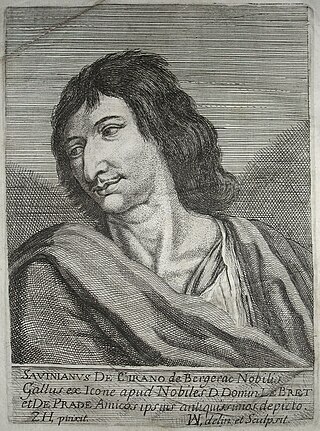
Savinien de Cyrano de Bergerac was a French novelist, playwright, epistolarian, and duelist.

Beauvais is a town and commune in northern France, and prefecture of the Oise département, in the Hauts-de-France region, 75 kilometres north of Paris.
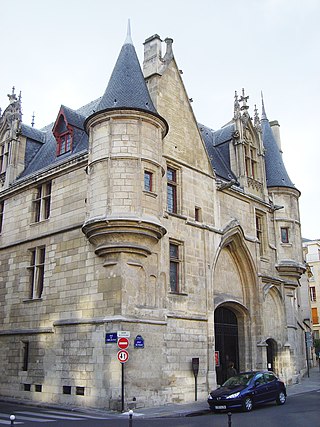
The Marais is a historic district in Paris, France. It spreads across parts of the 3rd and 4th arrondissements on the Rive Droite, or Right Bank, of the Seine. Having once been an aristocratic district, it is home to many buildings of historic and architectural importance. It lost its status as a fashionable district in the late 18th century, with only minor nobles calling the area home. After the French Revolution, the district fell into disrepair and was abandoned by nobility. After a long period of decay, the district has undergone transformation in recent years and is now once again amongst the more fashionable areas of Paris, known for its art galleries, upscale restaurants and museums.
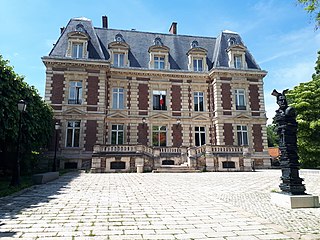
Courbevoie is a commune located in the Hauts-de-Seine Department of the Île-de-France region of France. It is a suburb of Paris, 8.2 km (5.1 mi) from the center of Paris. The centre of Courbevoie is situated 2 km (1.2 mi) from the city limits of Paris.

Jeanne Laisné, also known as Jeanne Fourquet in the 16th century and better known as Jeanne Hachette is an emblematic figure in the history of the French city of Beauvais' resistance to the siege laid by Charles the Bold, Duke of Burgundy. She is said to have helped to repel a Burgundian attack on the town of Beauvais with a hatchet and, in popular history, has been elevated to the rank of French heroine. She was born in Beauvais, around 1454, and died on an unknown date. The details of her life and even the fact of her existence, have been the subject of debate among historians, although several contemporaneous documents refer to her existence.

The Diocese of Beauvais, Noyon, and Senlis is a Latin Church ecclesiastical territory or diocese of the Catholic Church in France. The diocese encompasses the department of Oise in the region of Hauts-de-France. The diocese is a suffragan of the metropolitan Archdiocese of Reims. The current bishop is Jacques Benoit-Gonnin, appointed in 2010.

Jean-Baptiste Descamps was a French writer on art and artists, and painter of village scenes. He later founded an academy of art and his son later became a museum curator.

Flamboyant is a lavishly-decorated style of Gothic architecture that appeared in France and Spain in the 15th century, and lasted until the mid-sixteenth century and the beginning of the Renaissance. Elaborate stone tracery covered both the exterior and the interior. Windows were decorated with a characteristic s-shaped curve. Masonry wall space was reduced further as windows grew even larger. Major examples included the northern spire of Chartres Cathedral, Trinity Abbey, Vendôme, and Burgos Cathedral and Segovia Cathedral in Spain.

Jean-Baptiste Marie Huet was a French painter, engraver and designer associated with pastoral and genre scenes of animals in the Rococo manner, influenced by François Boucher.
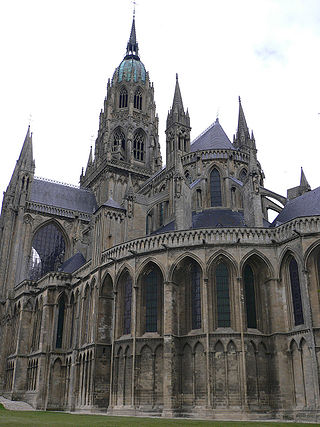
The Diocese of Bayeux and Lisieux is a Latin Church diocese of the Catholic Church in France. It is coextensive with the Department of Calvados and is a suffragan to the Archdiocese of Rouen, also in Normandy.
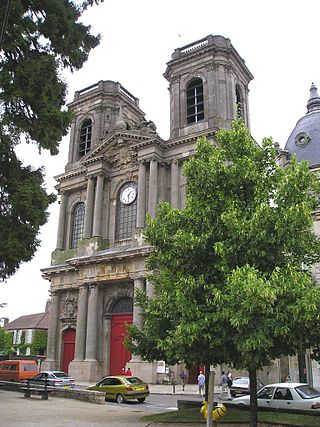
The Diocese of Langres is a Latin Church diocese of the Catholic Church comprising the département of Haute-Marne in France.

Jean-Baptiste Oudry was a French Rococo painter, engraver, and tapestry designer. He is particularly well known for his naturalistic pictures of animals and his hunt pieces depicting game. His son, Jacques-Charles Oudry, was also a painter.

The former French Catholic Diocese of Noyon lay in the north-east of France, around Noyon. It was formed when Saint Medardus moved the seat of the bishopric at Vermandois to Noyon, in the sixth century. For four centuries it was united with the bishopric of Tournai as the Diocese of Noyon–Tournai. Then in the twelfth century it was again independent, and the bishop of Noyon became a pairie-comté of France.
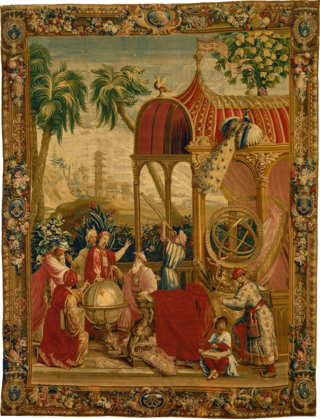
The Beauvais Manufactory is a historic tapestry factory in Beauvais, France. It was the second in importance, after the Gobelins Manufactory, of French tapestry workshops that were established under the general direction of Jean-Baptiste Colbert, the finance minister of Louis XIV. Whereas the royal Gobelins Manufactory executed tapestries for the royal residences and as ambassadorial gifts, the manufacture at Beauvais remained a private enterprise. Beauvais specialised in low-warp tapestry weaving, although the letters patent of 1664, authorising the company and offering royal protection, left the field open for the production of high-warp tapestry as well.

Jean Cholet was a French cardinal and Doctor utriusque iure at the University of Paris. His diplomatic skills helped prevent a duel between the kings of France and Aragon. He served as Papal Legate in France, and was responsible for organizing the Aragonese Crusade of 1283–84. He was then a working member of the Roman Curia.
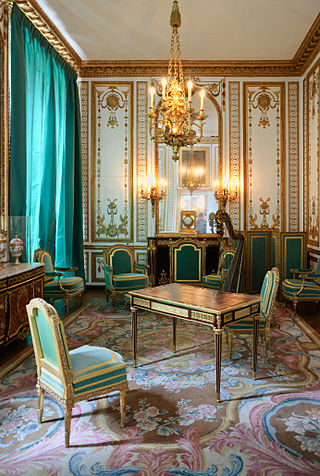
Louis XVI style, also called Louis Seize, is a style of architecture, furniture, decoration and art which developed in France during the 19-year reign of Louis XVI (1774–1792), just before the French Revolution. It saw the final phase of the Baroque style as well as the birth of French Neoclassicism. The style was a reaction against the elaborate ornament of the preceding Baroque period. It was inspired in part by the discoveries of Ancient Roman paintings, sculpture and architecture in Herculaneum and Pompeii. Its features included the straight column, the simplicity of the post-and-lintel, the architrave of the Greek temple. It also expressed the Rousseau-inspired values of returning to nature and the view of nature as an idealized and wild but still orderly and inherently worthy model for the arts to follow.

The Castle of Beauvais is a French château located in the municipality of Lussas-et-Nontronneau, department of Dordogne, region of Nouvelle-Aquitaine, France. The castle was listed as a historic monument on 19 December 1973.

Nicolas-Henri Tardieu, called the "Tardieu the elder", was a prominent French engraver, known for his sensitive reproductions of Antoine Watteau's paintings. He was appointed graveur du roi to King Louis XV of France. His second wife, Marie-Anne Horthemels, came from a family that included engravers and painters. She is known as an engraver in her own right. Nicolas-Henri and Marie-Anne Tardieu had many descendants who were noted artists, most of them engravers.

Jean-Benjamin François de la Borde was a French composer, writer on music and fermier général. Born into an aristocratic family, he studied violin under Antoine Dauvergne and composition under Jean-Philippe Rameau. From 1762 to 1774, he served at the court of Louis XV as premier valet de la chambre, losing his post on the death of the king. He wrote many operas, mostly comic, and a four-volume collection of songs for solo voice, Choix de chansons mises en musique illustrated by Jean-Michel Moreau. Many of the songs from the collection were later published individually through the efforts of the English folksong collector Lucy Etheldred Broadwood. His Essai sur la musique ancienne et moderne was published in 1780. La Borde was guillotined during the French Revolution in 1794.

Miles de Dormans was a French prelate, bishop and Chancellor of France in 1380.




















